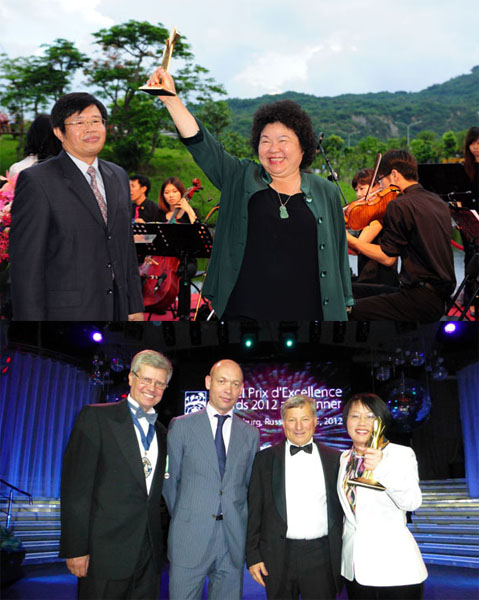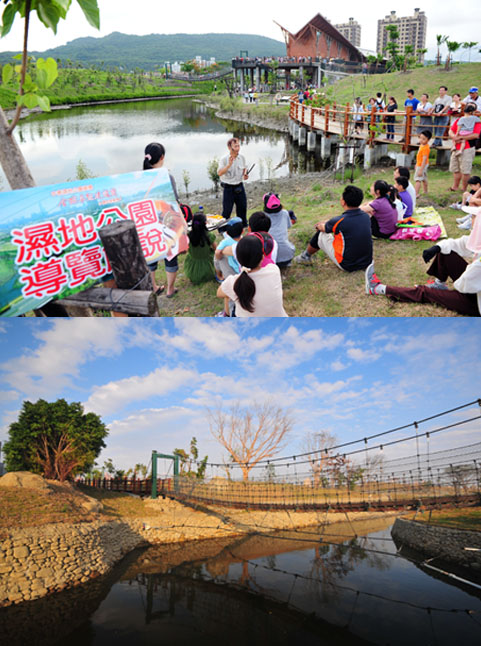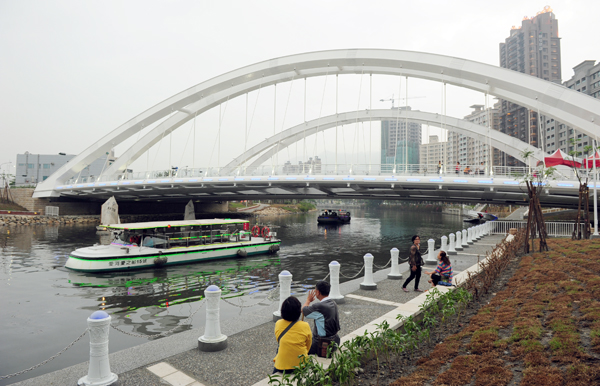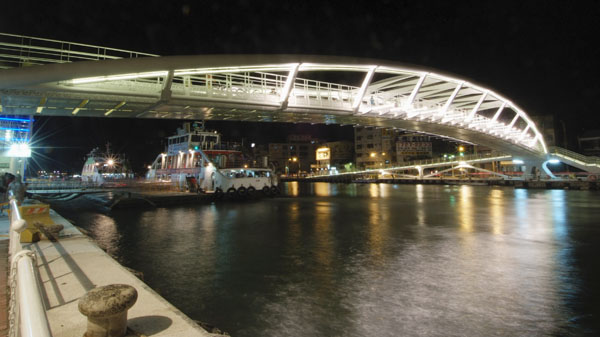| Outstanding Residential Metropolis – Kaohsiung City has Won Countless Awards |
Ms. Jhang, who lives in Zuoying District of Kaohsiung City, took her son and daughter on a bicycle ride along the Love River to Jhong Du Wetland Park during one weekend afternoon. In the past, her family usually traveled to other counties/cities during weekends by car, however, with the escalating oil prices, their travels have become less frequent. Nonetheless, they have not given up recreation and leisure activities, because she discovered that there are more green spaces in Kaohsiung that make great venues for weekend getaways. Gone are the days of distant car rides, because all the destinations can be reached by bicycle. Children get to run freely on the vast greenbelt, while they can also appreciate the local flora, fauna and ecology at a close distance. Such lifestyle has become common for parent-child gatherings in Kaohsiung. "Many of these green spaces have won international awards, thus coming here is comparable to traveling overseas!".
With an increasing number of quality green spaces designed around the public's comfortable living lifestyle and existing local ecological environments, they naturally blend into urban life and gradually transform the way of life and mentality of Kaohsiung citizens. With less crowding in the city, people are endowed with more greenness, thus their lifestyle becomes more leisurely and as a result, they become happier. Building public green spaces with considerations such as ecology and sustainability as priorities is the core architectural value being actively promoted in different countries throughout the world. Recently, several of Greater Kaohsiung's public constructions have received domestic and international awards; living up to international scrutiny and appraisal, the City Government is endowed with more confidence in shaping Asia's new maritime capital, thereby introducing even greater transformation and advancement for Kaohsiung. |
| Prix d'Excellence Award – Kaohsiung's Rise to Global Prominence |
 |
Since 2007, numerous public constructions in Kaohsiung have been awarded with recognition by the Taiwan Real Estate Excellence Awards. Furthermore, Kaohsiung has also represented Taiwan to attend the prestigious FIABCI Prix d'Excellence Awards and attained extraordinary results. The Taiwan Real Estate Excellence Awards, hailed as the Academy Awards of the architecture industry in Taiwan, have been organized in Taiwan for several years and therefore possess a credible reputation. The appraisal of Taiwan's architectural construction, public construction and environmental planning/design is performed by a professional panel of jurors. Participants span municipal public construction projects and private construction projects; each year, the most outstanding public construction projects and private architectural creations are recommended to the FIABCI to attend the annual grand event – the Prix d'Excellence Awards. |
| 四維行政中心 |
Kaohsiung City's public constructions have obtained excellent results each year, and 2012 is no different, with 27 Taiwan Real Estate Excellence Awards in total, including: Cianjhen Jhongshan 4th Rd. Crossing Kaisyuan Rd. Bikeway Bridge Construction and Kaohsiung Exhibition and Convention Center Turnkey Project, all of which received outstanding awards.
In addition, Kaohsiung has also won nine gold awards and 14 quality awards, making it the most prolific award winner this year. Moreover, the Jhong Du Wetland Park and Visitor-cum-Ecological Exhibition Center took the top honor in the rehabilitation/conservation category of the FIABCI Prix d'Excellence Awards. Since Jhong Du Wetland Park received the Taiwan Real Estate Excellence Awards for three consecutive years, it was presented with an overall achievement award. In total, from 2007 to 2012, Kaohsiung City has garnered the top honor of three FIABCI Prix d'Excellence Awards, namely for the Heart of Love River project in 2009, the She Zih Lin Basin Wetland Park Project in 2011 and this year's Jhong Du Wetland Park. This achievement has not only set a new record in Taiwan but also in the rest of the world, and global citizens will be able to witness the dedication of Kaohsiung City in creating an ecological metropolis. |
 |
| Jhong Du Wetland Park – New Paradigm of Urban Ecology |
Jhong Du Wetland Park, situated next to Tongmeng 3rd Rd., features suspension bridges, round-the-park-trails and an ecological interpretation center that attract numerous visitors every weekend. Although it is now a habitat for abundant bird species and surrounded by greenbelts, Jhong Du Wetland Park was actually a wood storage pool for Kaohsiung's timber industry in the past. Due to the decline of the timber industry and influence of urban development, the place had been reduced to a waste storage yard. It is difficult to imagine that the desolated area concealed a tropical strand forest consisting of dense mangroves that mark the border between the river and the ocean. When people began tracing the area's history and dedicated themselves to developing the Jhong Du region, they researched the natural environment's original appearance and purposely preserved the wetland park, thereby restoring the waterfront forest belt that once existed in Kaohsiung.
Within the 11.6 hectares of Jhong Du Wetland Park, a design to reduce the usage of rebar, concrete and building structures was adopted. The ecological island in the center of the park further employs narrow suspension bridges and zero nighttime illumination to minimize human interference on the environment. In addition, efforts were also made to restore the pristine appearance of the original environment. For instance, a 7m log excavated from the old canal was preserved, together with a precious old large-leaved banyan tree numbered "Sanmin 004". Furthermore, the original river course used for transporting logs was also retained; the river course connects to the seawater and the mixture of fresh/salt water environment is created by the Love River's tides. The place is conducive for the growth of mangroves such as Lumnitzera racemosa and Avicenia marina. Currently, the saplings on the sands next to the riverbank are actually thriving mangroves. Besides schools of fish in the river, insect cries and croaks of frogs can also be heard on the grassland or among the woods; there are also bird species taking refuge here. In the near future, when intertidal organisms such as fiddler crabs and mudskippers begin to return, the waterfront forest belt that existed in Kaohsiung several centuries ago will emerge once again. Ecological rehabilitation and conservation from near-extinction is a long and arduous process that requires the foresight of a city's leaders and the correct conservation concept. As a frequent winner of the Taiwan Real Estate Excellence Awards and FIABCI Prix d'Excellence Awards for its numerous wetland, park or green belt projects such as the Jhou Zai Wetland, which won the 2008 FIABCI Prix d'Excellence Awards, Kaohsiung City has left a memorable impression among international jurors with its concept of preserving natural urban wastelands to provide an oasis for diverse ecology.
In 2011, with joint efforts from community residents and the government, a polluted river was rehabilitated to create a community riverside greenbelt - She Zih Lin Basin Wetland Park, which also won the outstanding award of the FIABCI Prix d'Excellence Awards in the rehabilitation/conservation category. Other areas such as Aozihdi Forest Park, Yancheng Green Corridor, Fengshan Public Park No.28, Dapingding Tropical Botanical Garden, Yongan Wetland, and Fengshan District Dingjhuang Health Park have all received Taiwan Real Estate Excellence Awards. This goes to show that Kaohsiung is heading down the correct path to a more wonderful and sustainable future. |
| Enviable Living Environment Quality – Affirmation through Various Accolades |
The people of Kaohsiung get to enjoy natural wetland ecology in the city, which in turn restores the harmony of coexistence between people and nature. What is even more enviable is that we are blessed with many more greenbelt environments and comfortable living infrastructure in our everyday life.
Park greenbelts and sidewalk landscapes are endowed with a brand new appearance. The Kaohsiung City Government has long promoted the policy of converting vacant land into parks; as of May this year, the greenbelt area in Kaohsiung reached 1,845 hectares; this equates to 6.6 hectares of green space for each citizen on average. The park greenbelt design projects are as closely linked to the local geographical environment and community culture as much as possible.
The planning of green parks is an important objective of elevating urban living quality; in the densely populated Fengshan District, Dadong Park, Public Park No.28, Wujia Park and Dingjhuang Health Park have all been completed. Dadong Park and Public Park No.28 are combined with the Fengshan River Dredging Project, Fengshan Riverbank Greenbelt, bikeway and park design to create thematic natural recreational venues through landscape design and planning. In particular, Wujia Park has preserved old trees such as banyan trees and Taiwan Zelkova in the nearby armament factory to create the banyan forest trail and Memory Square, thereby preserving the historic memories of the Wujia region. The diverse array of unique green spaces now form the best recreational venues for residents. |
| Prix d'Excellence Award – Kaohsiung's Rise to Global Prominence |
 |
Amidst the verdant cityscape, there are several construction designs that infuse vivacity into the spaces that have also received Taiwan Real Estate Excellence Awards; they are set to transform the ambiance of the region as new landmarks in Kaohsiung and reshape people's lifestyles. The Jhong Du Park Avenue Vision Bridge strikes a white arch across the sky that connects the Fine Arts Museum area with Jhong Du Wetland Park; it is expected to catapult Jhong Du into a quality community for residential, commercial, recreational, leisure and cultural activities. The 4.5m wide bikeway/sidewalk space on either side of the vision bridge serves to link the Love River bikeway system that connects scenic spots such as the Fine Arts Museum, Neiwipi Cultural Park with Jhong Du Wetland Park and the Jhong Du Tangrong Brick Kiln historic monument. |
Additionally, in conjunction with the Love River Upstream Sailing Project, the Love Boat travels upstream to reach the Heart of the Love River at Boai Rd. and connect with the KMRT Red Line Aozihdi Station to form a land-water transportation hub, in turn attracting tourists to Kaohsiung City.
Kaohsiung City's image as a bicycle city is internationally acclaimed. Through intricate, comprehensive bikeway planning, we strive to constantly establish connections between different routes and create a safe biking environment. Three of Kaohsiung's bikeway bridge constructions have also received Taiwan Real Estate Excellence Awards, including: Gushan District Hamasen Pier 1 Scenic Bridge, Cueihua Bikeway Exclusive Bridge and the Cianjhen Jhongshan 4th Rd. Crossing Kaisyuan Rd. Bicycle Bridge. After completion in September this year, it will not only connect the Harbor Line Bike Path with the bikeway system on Cueiheng Rd. and Jhongshan Rd., but also solve the problem of bike traffic crossing Kaisyuan Rd. from KMRT R6 Kaisyuan Station to the local community, thereby offering the public a safe biking environment.
The crucial goal of Kaohsiung City is creating a green ecological city, and the "user/localization" concept is the core design for numerous public infrastructures in Kaohsiung. Through the approach of "nature-orientation", Kaohsiung is set to become a green, vivacious ecological metropolis with a fusion of balanced regional development, culture, humanity and aesthetics. |
| The International Awards for Liveable Communities |
 |
Greater Kaohsiung's environmental constructions have been honored with countless awards besides the FIABCI Prix d'Excellence Awards. Kaohsiung also participated in the International Awards for Liveable Communities organized by the United Nations Environment Programme (UNEP). This is the only international competition emphasizing the promotion of environmental management and liveable construction. The objective of the competition is to find the best examples of sustainable urban development around the world, so as to provide global citizens with an eco-friendly development model that is full of energy and sustainability, thereby enhancing their quality of life. For participating cities/communities, this is an opportunity to further promote their international reputation and exchange environmental management experiences with other cities/communities worldwide. |
| The judging standard of the International Awards for Liveable Communities is extremely stringent, with the juror panel consisting of environmental protection and landscape management professionals. The competition categories are divided int Whole City Awards, Project Awards and Bursary Awards. The participating cities/communities are categorized according to five population classes (A: Below 20,000 people, B: 20,001~75,000 people, C: 75,000~150,000 people, D: 150,001~400,000 people, E: More than 400,000 people). The participating cities/communities are not judged against other participants in the same group, rather they are compared according to six judging criteria such as: 1- Enhancement of the Natural and Built Landscape, 2- Arts, Culture and Heritage, 3- Environmental Best Practices, 4- Community Participation and Empowerment, 5- Healthy Lifestyle, and 6- Strategic Planning. |
| Kaohsiung's Debut Produced Outstanding Performance |
For Kaohsiung’s first attempt at the awards, it demonstrated outstanding results and stood out among 77 cities in 26 countries by clinching two gold awards, one silver award and one bronze award in the architecture category with entries such as the World Games Main Stadium, Cueihua Bikeway Exclusive Bridge, Houjin Stream Remediation & Yicyun Landscape Bridge and Jhong Du Wetland Park. At the same time, Kaohsiung was also the most prolific award winner among other participating municipalities in Taiwan such as Yilan, Tainan and Taitung.
All four construction entries in the competition have incorporated the six major indicators specified by the organizer; for future urban construction, hardware is no longer the sole consideration, other aspects such as environmental protection, sustainability and culture must also be taken into account. The open architecture of the World Games Main Stadium, the solar panel roofs and Jhong Du Wetland Park all represent the iconic urban architecture of Kaohsiung City in terms of improvements in environmental protection, nature and cultural landscapes.
For Cueihua Bikeway Exclusive Bridge and Houjin Stream Remediation & Yicyun Landscape Bridge, the projects seamlessly blend into the local environment by creating a more convenient, healthy lifestyle for citizens; their exquisite design serves to revitalize the urban landscape. They are the lifeblood that invigorates the city’s tourism and economic development while allowing urban construction to coexist with the environment in a symbiotic and harmonious manner, in turn transforming Kaohsiung into a city of happiness conducive for living and traveling.
The judging standard of the International Awards for Liveable Communities is extremely stringent, with the juror panel consisting of environmental protection and landscape management professionals. The competition categories are divided int Whole City Awards, Project Awards and Bursary Awards. The participating cities/communities are categorized according to five population classes (A: Below 20,000 people, B: 20,001~75,000 people, C: 75,000~150,000 people, D: 150,001~400,000 people, E: More than 400,000 people). The participating cities/communities are not judged against other participants in the same group, rather they are compared according to six judging criteria such as: 1- Enhancement of the Natural and Built Landscape, 2- Arts, Culture and Heritage, 3- Environmental Best Practices, 4- Community Participation and Empowerment, 5- Healthy Lifestyle, and 6- Strategic Planning. |
Source:Information Bureau Kaohsiung e-Publications Portal, Kaohsiung Pictorial 2012/07,Photos by Pao Chung-hui
翻譯資料來源(正體中文):來源一、來源二 |
|